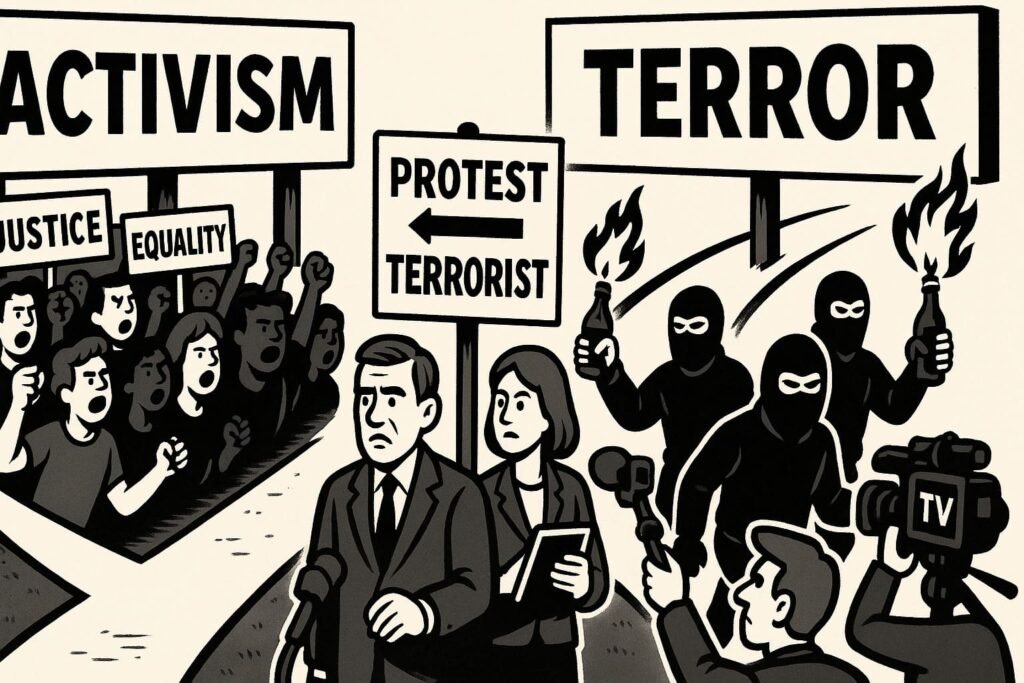Terror vs Activism Explained – Where Violence Gets Justified
One man’s freedom fighter is another man’s terrorist. The trick is deciding who writes the press release.
Every activist swears they’re fighting for justice. But what happens when protests turn violent? Windows smashed, police attacked, bombs planted. Is it still activism — or has it crossed into terror? For decades, movements have danced on this line, and society has been remarkably forgiving when the cause is fashionable.
Table of contents
What’s the Difference?
- Activism → persuasion, protest, civil disobedience. The goal is visibility and pressure.
- Terrorism → intimidation, violence, fear. The goal is coercion by force.
In theory, the line is clear. In practice, it blurs fast:
- A sit-in is “peaceful.”
- A Molotov cocktail is “mostly peaceful.”
- A bombing is “resistance.”
It often depends less on the act, more on who supports the cause.
How It Shows Up in Practice
- Antifa riots → branded as “direct action” by supporters, as terrorism by critics.
- Eco-sabotage → pipelines blown up in the name of climate justice. Activism or eco-terrorism? Depends who you ask.
- Middle East conflicts → Western politicians label some groups terrorists while applauding others for “resistance.”
- Jan 6 vs BLM → one becomes “insurrection,” the other “protest,” though both saw violence and destruction.
The rhetoric flexes to suit politics.
Who Benefits?
- Activists → violence creates urgency, fear, and media attention.
- Politicians → can downplay or exaggerate violence depending on who’s doing it.
- Media → chaos sells. Nothing gets clicks like fire, smashed glass, or blood in the streets.
The Consequences
Once violence enters activism, the stakes change:
- Legitimacy → movements risk losing mainstream support.
- State response → harsher laws, police crackdowns, surveillance justified.
- Public trust → eroded, as ordinary people start seeing every protest as a potential riot.
The irony: governments sometimes need violent activism. It justifies new powers, budgets, and control. Activists, in turn, justify their escalation by pointing to state repression. It’s a vicious feedback loop.
Conclusion
The line between activism and terror isn’t drawn in law books — it’s drawn by politics. What counts as “justice” for one side will always be “terror” for the other. The danger is when society accepts violence as normal activism. At that point, we’re not debating policy anymore. We’re negotiating with fear.
👉 Want the bigger picture? Explore our full Activism Explainer Hub to see how movements, tactics, and ideologies shape modern politics.
FAQ
What is the difference between activism and terrorism?
Activism uses protest and persuasion; terrorism uses fear and violence. In reality, the line is often blurred by politics.
Why do activists justify violence?
They argue that the system ignores peaceful protest, so escalation is “necessary.” Critics call it coercion.
Has violence ever worked for activists?
Sometimes. Violence can force media attention or concessions, but usually at the cost of public support.
Why do governments treat similar violence differently?
Because “terrorist” is a political label — applied to enemies, excused for allies.
Is all violent activism terrorism?
Not legally. But morally, once violence becomes the tool, it leaves the realm of persuasion.



